Some folks would say youʼd have to be mad to travel half way around the
world to collect quartz crystals. I am crazy for quartz, particularly when the
specimens in question are smoky quartz from Mooralla, Australia. Perhaps those same folks would say I could have ended the previous sentence after the 3rd word, but those folks would not be mineral collectors. Mooralla smoky quartz crystals are unique in the world. They somewhat resemble “Herkimer
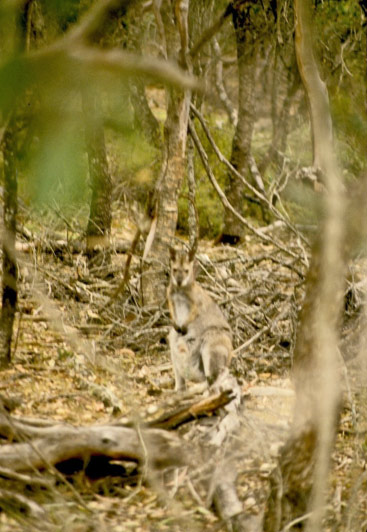
diamonds”, being doubly-terminated, extremely lustrous,and equidimensional.
The flight from Seattle to LA to Melbourne is long, but the November skies were smooth,and I managed to sleep for half of the LA-Australia leg, which departs LA late evening. This was my 12th visit in 20 years, so I knew what to expect. My last flight there was on United, which seemed to have had its seats designed
by a pickle-packer, so I took my chances with a new airline, VAustralia, the newest of Bransonʼs Virgin-clones, and was pleasantly surprised. Arriving relatively refreshed, I gathered my bags and caught a bus to Ballarat, the eastern-most point of the Aussie Golden Triangle, the equivalent of
Californiaʼs Mother Lode country. My old friend Doug met me there with his ʻuteʼ (pickup truck) for the 3 hour drive to Mooralla.
Mooralla is the name of a station, the Aussie equivalent of a ranch. The original station comprised over a thousand acres, but the digging area is set aside as a public ʻfossickingʼ (rockhounding) area. Australiaʼs mining laws are quite different than our US laws. All mineral rights are held by the government, including those on private land. The original station owner of Mooralla found smoky quartz crystals on the surface while tending sheep, and told a neighbor, who filed a mining claim on it. Claims of interest to fossickers can be turned into permanent public collecting areas, which is what
happened at Mooralla. So this formerly private land is now set aside for fossicking and is one of the Aussie destinations for rockhounding tours led by yours truly for GeologyAdventures.com.
Our camp is in the bush, about an hour south of the nearest country town, so once there, we settle in for a month. My tour business causes me to spend about a third of every year camping out ... Mooralla is a most comfortable camp. I reside in a tent, Doug has a trailer outfitted with frig and freezer, so on our way in we fill the ute with frozen food and beer. Evenings at Mooralla are sublime: dinner cooked on the barbie, collectors cooked by the sun cooling off with a cold one, hot water for a shower warming in a bucket, kookaburras laughing and cockatoos scolding as the sun sets behind gum trees.
Doug arrived at Mooralla a week before I did, and had set up camp and gotten a hole started. The hole-starting process involves putting up a 20 X 20 ft. tarp, for sun and rain protection, and slicing chunks of clay out of a 10 X 10 foot surface.
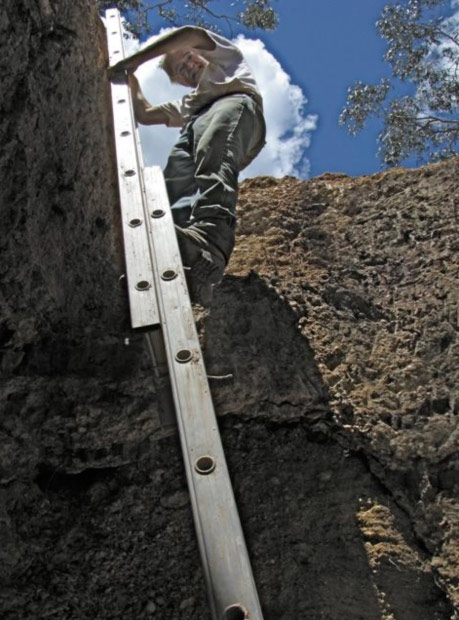
Author looking down the ladder with hole at 18 ft.
The clay is derived from an Eocene rhyolite flow. Over the past 40-odd million years, the rhyolite has decomposed to clay. The smoky quartz crystals formed in lithophysae, aka: thundereggs. The clay shows the sub-horizontal banding of the original rhyolite, and varies from a moist, elastic, dense medium that sticks to your shovel, to a hard adobe like substance. Depending on recent rainfall, the hole starting process can take from a day to a week.
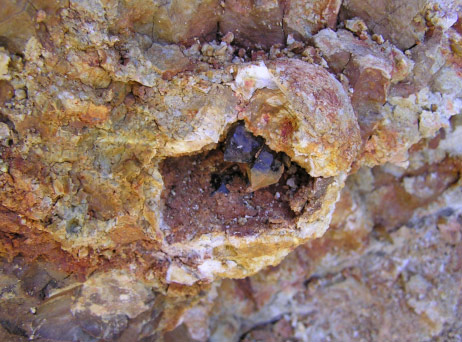
Lithophysae in situ
Once you dig through the surface clay, the material becomes more uniform. About 5 ft. down is a red clay zone that marks the beginning of the lithophysae-bearing area. Fossicking areas require that only hand tools be used, so we set up a hand-powered rope windlass to haul the muck out of our hole. As the hole deepens, more time is required to remove each round of waste. In a week we were down 10 ft; by the end of the second week, 16 ft.
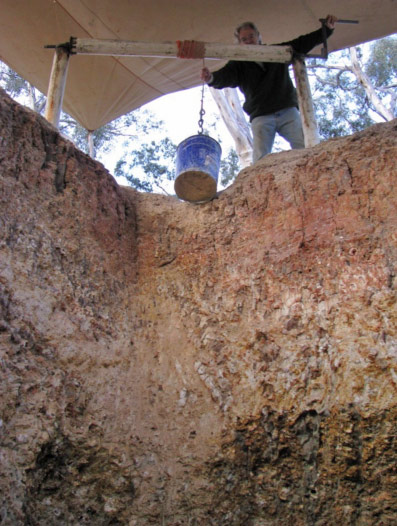
Muck leaves the hole by windlass. An hourʼs digging in
a 10 X 10 ft. hole requires 20 minutes of hoisting buckets.
As we continued down, we encountered layers where lithophysae were abundant.
Collecting crystals is a lot slower than digging clay, so our downward progress slowed. The third week we only dug 4 ft. of muck, but produced over a thousand crystals. Every evening we cleaned our daily take of ʻeggsʼ, at least enough to judge the quality of the crystals found.
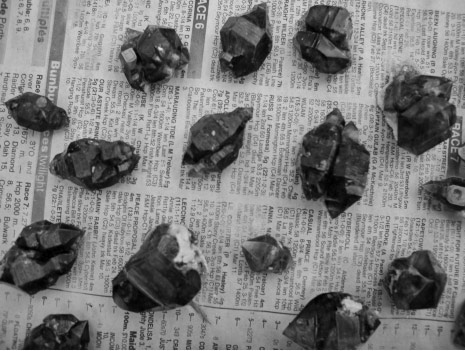
Part of the dayʼs production, drying after evening cleaning.
At least 50% of the smokies are doubly-terminated. Fast growth
(vapor phase) caused frequent inclusions and enhydros.
During our third week, we struck a layer of large eggs, up to a foot in diameter. Eggs this large are uncommon at Mooralla.
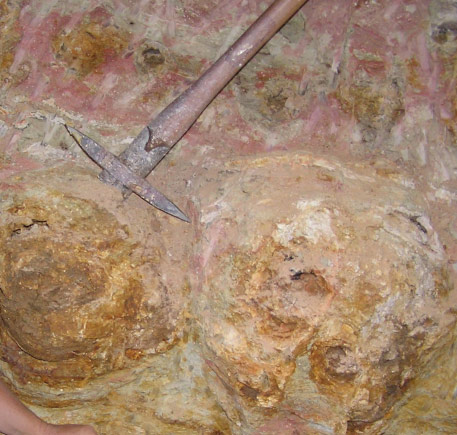
Large eggs in a grey clay horizon. Note band of normal-sized
eggs (+/- 3 inches) in pink clay band above. Pick head is 10 inches.
It is hard to imagine how the crystals formed in these lithophysae, as they are so densely packed there is little room for the clay. Almost every egg, even tiny ones, will have at least one smoky, usually sitting on a bed of small, clear quartz druse. Larger eggs will contain multiple plates of smokies attached to thin shells of silicified rhyolite. Opening a large egg is like peeling an onion. That
week I returned to Melbourne to pick up a group of visitors from the U.S. & Canada; they had the experience of digging out one egg after another. When the eggs are widely separated, it is easy to pop them out with a deft swing of a pick, but when they are tightly packed, much delicate work is required to avoid damaging the crystals.
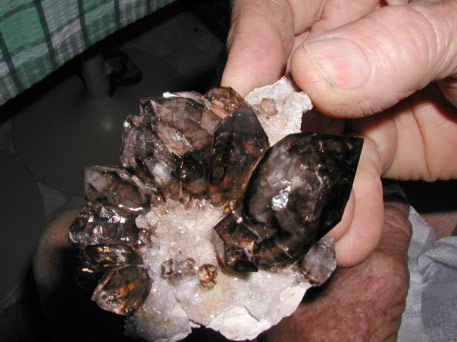
Mooralla smoky quartz on clear drusy matrix
During our 4th week, the rainy system that had caused floods in Queensland
reached Victoria. Working the hole in the rain is normally no problem, as the large tarp shunts the water away from the hole. Walking between camp and the hole can be an adventure, as the clay ground surface is extremely slick, and your boots quickly accumulate many pounds and inches of gooey clay. After 3 days of nearly-continual rain, we decided that maybe a visit to town was in order. The access to the locality requires fording two creeks, normally dry in November. The first time I looked, there were 6 inches of water in the creek. The second time, 2 hours later, the creek was 18 inches deep and moving quickly. Since my flight home was scheduled later that week, it seemed a good idea to make a run to town. Was glad we did, as 2 days later our camp area was submerged. The zone in the bottom of the hole was encouraging, weʼll return to dig it back out another year.